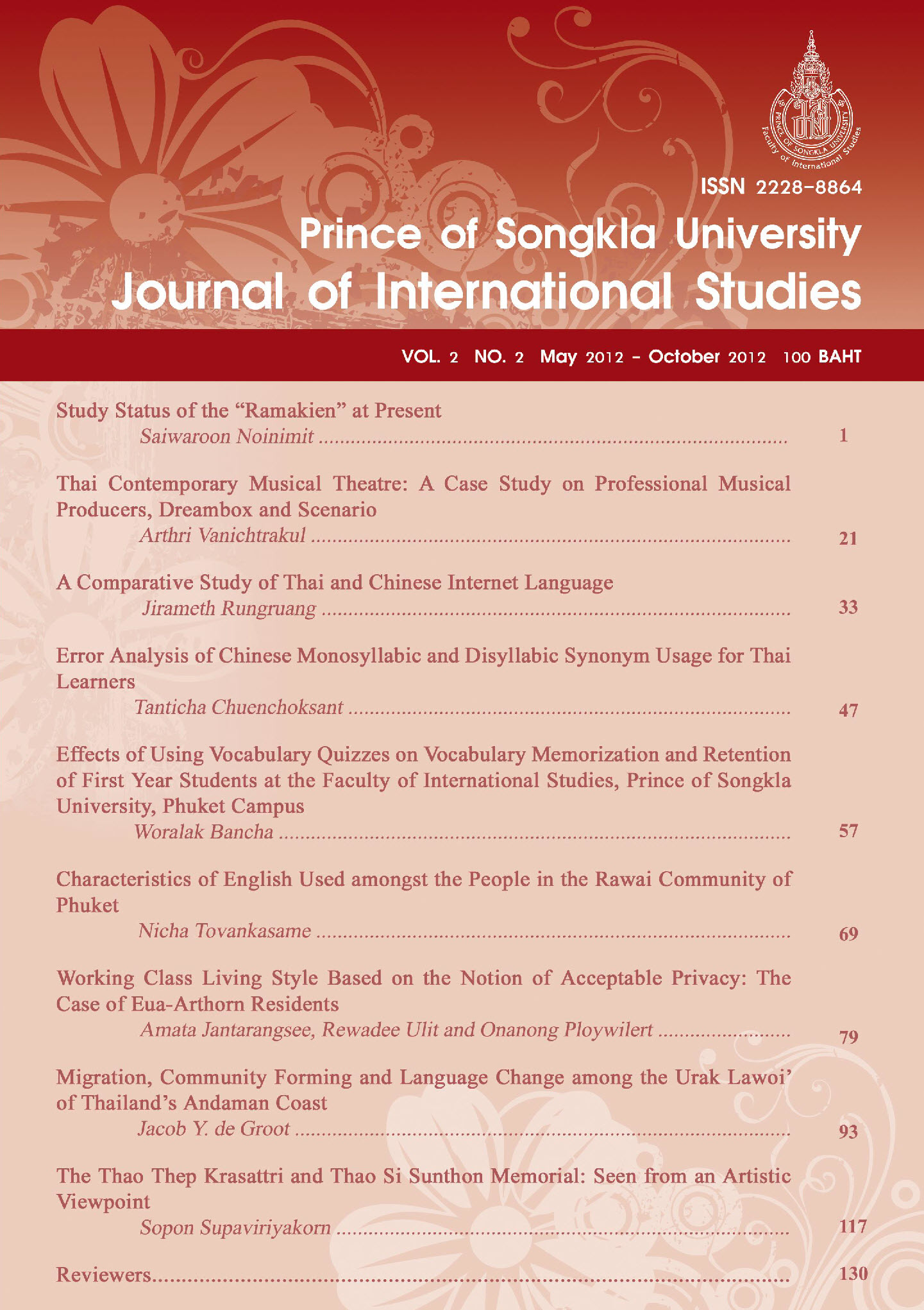Migration, Community Forming and Language Change Among the Urak Lawoi' of Thailand's Andaman Coast
Main Article Content
Abstract
In this is paper the link between migration, community forming and language change of the Urak Lavoi' (UL) people is made evident. My own descriptive and comparative linguistic de research, conducted from February 2010 until January 2012 in several Urak Lawoi' communities on Thailand's Andaman coast has supplied most of the data that constitute the hasis of this paper. Some comparative and supportive data have been selected from earlier research, notably that by Thawisak (1986) and Wongbusarakum (2002).
Urak Lawoi' is a highly adaptive language that has developed alongside other Malay languages within the Malayan group (which also includes Para-Malay languages as Minangkabau and Temuan). Like the vocabulary of other Malay languages, such as Johor Riau, Jambi, Kedah, Bengkulu and Pattani, that of UL is for the greater part cognate with the modern standard Malay (SM) languages, the most well known of which are the national languages of Malaysia (Bahasa Malaysia; BM) and Indonesia (Bahasa Indonesia; BI)'. When spoken, UL cannot be properly understood by speakers of SM. This is, however, primarily que to certain regular sound changes that have occurred during the last few centuries. By paring UL with other Malay languages, and by considering loans in vocabulary and war which have occurred over time, we can define the place where the Urak Lawoi' lated as a people, where they migrated from there, and in which places they chose to semi-permanently before making Southern Thailand their permanent domicile.
The Urak Lawoi' have a lot in common with other Malay people, but there things in which they differ. Originally a nomadic sea people, they have hardly be and never been Islamized, and until today hold on to their original animistic be as they were, the Urak Lawoi' have been in contact with many other peoples and although they never yielded to complete adaptation to a dominant society's cut recently gave up their nomadic life style, they were still to an extend influenced by they came into contact with. Many of these influences are reflected in the Urs language. Urak Lawoi' has loaned from, among other languages, Sanskrit, margin Arabic (via SM), from SM, English - directly and via SM - and most recently from even though no written sources about the ethnic homeland of the Urak Lawo considering natural phonetic change as well as loaning and grammatical influen surrounding languages we can trace back the path that the Urak Lawoi' people to their place of origin - which lay along the east coast of Sumatra - with comparative paper offers to point out how migration, community forming and settlement of the Lawoi' is mirrored in their language. skrit, marginally from cently from Thai. So Irak Lawoi' exist, by atical influences from Lawoi' people took from with comparative ease. This paper offers to point out how migration, community forming and settlement of the Urak Lawoi' is mirrored in their language.
Article Details
Statements and opinions expressed in articles herein are those of the authors and do not necessarily reflect the position of the editors or publisher.
Article, information, text, image, etc. which are published in Journal of International Studies, belong to Journal of International Studies. If anybody or any organization would like to use part or whole of them, they must receive written permission from Journal of International Studies before usage.
References
identification of basic ways for marine tourism in Tarutao Island National Park.
Hadyai: Prince of Songkla University. Groot, J.Y. de (2012). Urak Lawoi' Language and social history. Phuket: Prince of Songkla
University Hogan, D. and Pattemore, S.W. (1998). Urak Lawoi': Basic structures and dictionary.
Canberra: Pacific Linguistics Leonard, A. (1974). The structure of power in seventeenth century Johor. In Anthony Reid
and Lance Castles (eds.) Pre-colonial state systems in Southeast Asia: the Malay Peninsula, Sumatra, Bali-Lombok, South Celebes, pp.1-11. Kuala Lumpur:
Monographs of the Malaysian Branch of the Royal Asiatic Society, No. 6 Mahidol University Project on Education and Research on Environment. (1974). Report
on preliminarysurvey of Tarutao National Marine Park. Bangkok: Mahidol University. Muljana, S. (2006). Sriwijaya. Yogyakarta: PT LKiS Pelangi Aksara Ricklefs, M.C. (2001). A history of modern Indonesia since c.1200, 3rd Edition. Stanford:
Stanford University Press Stevens, A.M. and A. Ed. Schmidgall-Tellings (2009). Kamus Lengkap Indonesia-Inggris.
Bandung: Mizan Media Utama Thailand Bible Society. (1998). The New Testament in Urak Lawoi'. Jarkata: Lembaga
Alkitab Indonesia. Treaty between the United Kingdom and Siam, signed at Bangkok, March 10, 1909. (1909).
London: Harrison and Sons. U.S. Center for World Mission (2012). Joshua Project: Urak Lawoi of Thailand
Retrieved March 20, 2012 from http://www.joshuaproject.net/people-profile.php?
peo3=15722&rog3=TH Wongbusarakum, S. (2002). The Urak Lawoi and the complexity of sustainable resource
.. The political ecology of change in the Adang Archipelago, Andaman Sea, Thailand. Hawaii: University of Hawaii.


